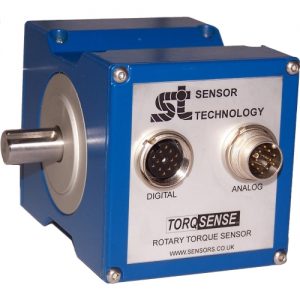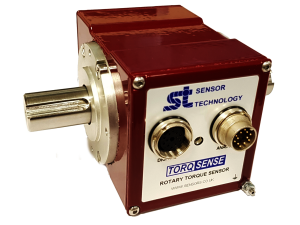British innovation looks set to storm through Germany industry, following the massive interest generated by the launch of Sensor Technology’s new non-contact torque sensor at the Hannover Fair.
 To date measuring torque in a rotating shaft has involved complicated engineering to set up a system of slip rings or other expensive measurement techniques. Because of this torque measurement has been confined to only specialist areas of control engineering, such as research and development.
To date measuring torque in a rotating shaft has involved complicated engineering to set up a system of slip rings or other expensive measurement techniques. Because of this torque measurement has been confined to only specialist areas of control engineering, such as research and development.
Close monitoring of drive shafts would provide accurate real time information on the performance of production machines in every sector, but to date has not been practical in the vast majority of situations.
Senor Technology Ltd, based in Banbury, Oxon, UK has been working on non-contact shaft monitoring for some years and used the Hanover Fair for the European launch of its new RWT310/320 series of TorqSense rotary torque sensors. This encapsulates the techniques they have perfected and is designed for serial production so that it can be introduced to mainstream engineering.
“We expected plenty of interest from show visitors representing the academic and R&D end of engineering,” says Tony Ingham of Sensor Technology, “but thought we might have to fight a bit to whip up enthusiasm among plant and control engineers from manufacturing and process environments. How wrong we were!”
He thinks that the interest in TorqSense illustrates one of the fundamental strengths of Germany’s engineering and manufacturing sectors. Many of their engineers, even those in quite junior positions, hold doctorates, so are highly conversant with the concept of developing and applying innovative ideas. They also tend to serve their time on the shop floor where they learn not only the practicalities of engineering but also how and why to push through new working methods.
“German factory engineers spend their days at the leading edge of technology and have budgets for developing new ideas,” observes Ingham. “When they see something new they run down their own mental check list of places where they could apply it. If they get more than a couple of ticks their antennae go up.”
“Because most machines include at least one important rotating shaft, they saw TorqSense and wondered if it was Christmas!”
TorqSense does not need physical contact with the shaft it is monitoring; instead it uses a radio frequency (RF) coupling to both power and read the output of a tiny piezoelectric comb mounted on the shafts surface and acting as a hypersensitive strain gauge. During rotation all shafts twist at a microscopic level and this deforms the comb so that its fundamental frequency changes. The twist and therefore the frequency change are directly related to the torque in the shaft, so monitoring the comb gives a direct measure of torque.
The RWT310/320 TorqSense is designed for plug and play fitting. It comes with integral electronics, outputs for torque, speed, power and angle, analog and/or and digital outputs, and is directly compatible with most popular PC Interfaces.
It is user programmable, a feature Sensor Technology worked hard to perfect fearing that if it were difficult to use it would remain a tool for development ‘boffins’ rather than being attractive to the full range of engineers.
Other innovative features include built-in peak torque sampling, storage and torque averaging, and a self-diagnostics test package. Both the RWT310 and RWT320 can operate from a wide range of supply voltages.
“Hannover is of course an international event and we saw engineers from many, many countries, but it was the Germans’ enthusiasm that we were most pleased with. Germany is still the powerhouse of European manufacturing, it is well positioned to influence the newest EU members and other countries to the east and its technology is transferring to the new manufacturing economies in Asia.”





